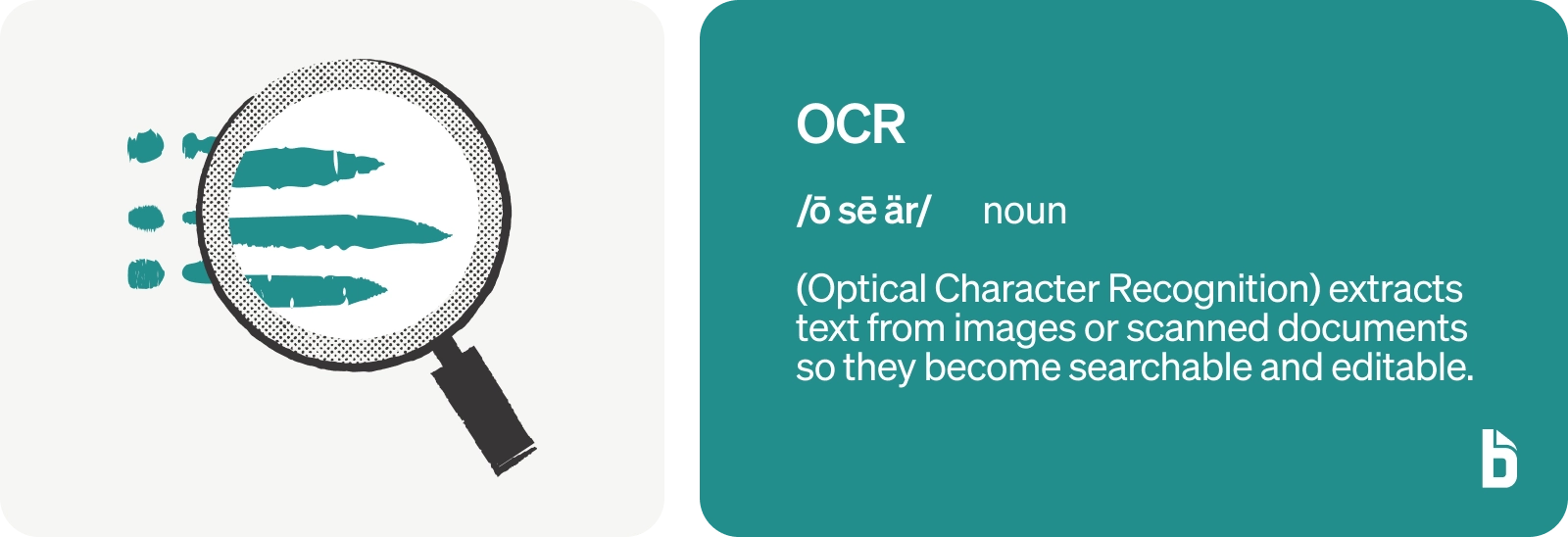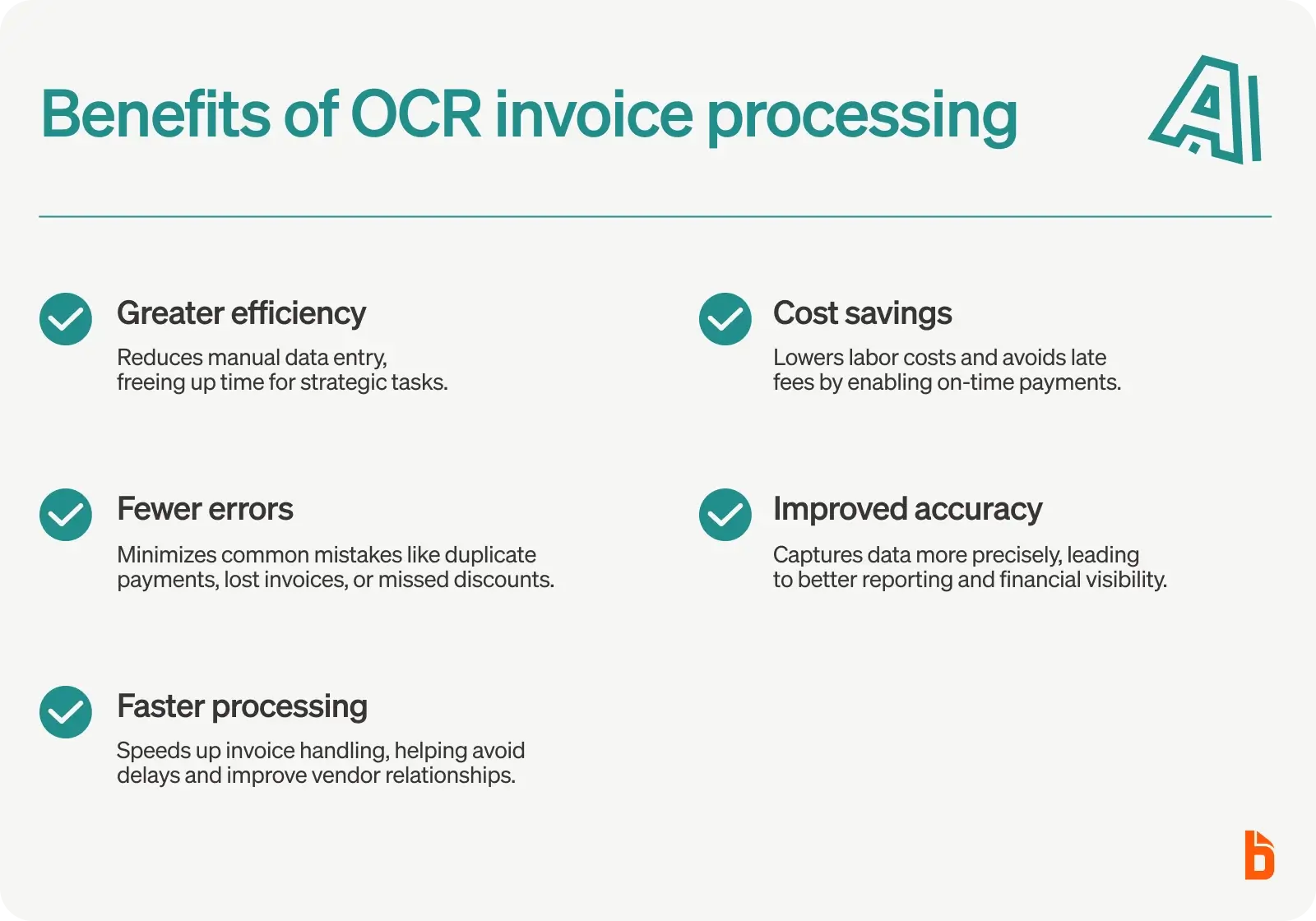For the sake of efficiency, many businesses are turning away from manual invoice processing in favor of using an automated system.
In fact, a reported 44% of companies in the US are looking to automate more of their accounts payable processes.
At face value, automated invoice processing seems to work like magic, ensuring vendor payments are made on time and properly recorded in your accounting system.
But behind the scenes, there’s an important piece of technology making it all happen–optical character recognition (OCR).
No matter how you receive invoices, converting them into a digital format that your AP solution can understand is a crucial function of OCR.
It’s how you can trust that your automated system is making accurate and reliable vendor payments with minimal intervention from your team.
Throughout this guide, we’ll define optical character recognition, discuss its role in automated invoice processing, and outline the main steps of the OCR flow.

What is optical character recognition (OCR)?
OCR, or optical character recognition, refers to the process of pulling text values from images, PDFs, or other types of read-only files.
This technology allows you to take paper documents or digital scans and turn them into a format that is searchable and readable by machines–like your AP program.
For instance, if you scan a paper invoice you’ve received from a vendor, it will simply be stored as an image file on your computer.
At this point, you cannot search for specific text contained in the image or make any edits to the scanned document.
In other words, you’ll have a digital copy of the invoice but you’ll still have to manually input the data from the document into your AP system.
On the contrary, OCR takes the contents of the scanned document and turns it into a text file that your AP system can process and edit with little manual data entry required.

How can OCR automate invoice processing?
If you want to improve the efficiency of your accounts payable department and become less reliant on manual data entry, OCR technology can help automate time-intensive workflows, including invoice processing.
Without OCR, your team must manually scan each incoming invoice to document important data and input it into your financial software so the payment can be processed, including:
- The vendor’s name
- The invoice amount
- Payment due date
- The invoice number
- Line items of each good/service delivered
Plus, you still need to match up the details from each invoice against the corresponding purchase orders (for two-way matching), purchase orders and receipts (three-way matching), and potentially a quality inspection report (four-way matching), to check each one for legitimacy.
All of this takes up valuable resources from your team, which will continue to pile up as you grow your business and work with more vendors.
But, OCR technology can automate a good portion of these workflows.
It scans invoices stored as image files or PDFs to extract critical information and convert them to a text-based document that your AP software can read and understand.
From there, your AP system has the data it needs to verify each invoice against relevant documents, retrieve the appropriate approvals, and time payments ahead of their due dates.

Benefits of OCR invoice processing
Automated invoice processing with OCR offers several important benefits for accounts payable departments, which we’ll now discuss in more detail.
Better efficiency
OCR allows you to be more hands-off with invoice processing, which can be a tedious and time-consuming task.
Primarily, OCR reduces the need to manually extract data from invoices and input it into your financial system.
As a result, you can spend less time on data entry and have more resources to dedicate to strategic work like financial analysis or vendor contract negotiations.
Lower risk of errors
Even the most experienced staff in your AP department can make mistakes sometimes, which can be extremely costly depending on the nature of the error.
OCR helps you avoid making mistakes like:
- Paying an invoice twice
- Transposing values
- Overpayment
- Lost invoices
- Late payments
- Missed early payment discounts
When you reduce your reliance on manual data entry, you can lower the risk of these common human errors.
Quicker invoice processing
With a manual system, your ability to process invoices is dependent on the finite resources of your team.
This may be feasible when you’re just starting out, but as you add more vendors and the number of incoming invoices grows each month, this can quickly bog down your productivity and lead to late or missed payments.
According to a survey done by the Institute of Financial Operations and Leadership (IFOL), 22% of finance professionals reported their top AP challenge was the delays caused by time spent processing invoices.
Luckily, OCR can help by speeding up this workflow.
OCR technology can quickly process large volumes of invoices, helping you complete this task faster, make on-time payments, and improve your vendor relationships as a result.
Possible cost savings
Manually processing invoices at scale often requires additional headcount.
OCR can help you reduce your direct labor cost by allowing you to scale without making new hires.
In addition, OCR can help you make on-time vendor payments, which provides further cost benefits as you avoid late payments or fees and take advantage of early payment discounts where applicable.
Improved accuracy
OCR captures important information from documents with a high degree of accuracy, reducing the risk of discrepancies between what’s shown on the invoice and what’s input into your system.
This enhanced accuracy leads to more precise reporting, helping you gain better visibility into your current cash flow levels and overall financial health.

The 5 steps of the OCR invoice processing flow
There are a few key steps in the OCR process flow that ensure your AP system can read and understand the text found in your scanned invoices, including:
1. Creating a digital copy of the invoice
When you’re using OCR to simplify invoice processing, the first step is to get a digital copy of the document.
If the vendor emails you the invoice, this will be your starting point.
But, if you still receive physical copies from certain vendors, you will need to scan or upload it so you have a digital version.
2. Enhancing the image
There may be certain adjustments made to the image file before proceeding, like changing the brightness or contrast, straightening edges, improving clarity and resolution, removing dust particles or smudges, or other fixes.
This step is done to make sure that the image is viewed clearly and can be accurately processed by the OCR software.
3. Identifying characters
Now, each pixel is scanned to detect any numbers, letters, or symbols within the image. Any recognizable characters identified on the page are converted into the corresponding text values.
The system may even cross-reference or compare the patterns it’s detecting against a database of font styles to ensure the accuracy of what it has identified.
4. Extracting text and data
OCR software then takes a look at each of the individual characters and pieces them together to create logical words and sentences that match what’s shown in the image.
The program will take the relevant text values from the image and input them into the AP system in the appropriate fields.
5. Validating for accuracy
Your team may take a final glance over the system’s output, checking to see if anything stands out as inaccurate or incomplete before the invoice is submitted for approval.
This adds another layer of validation where your experienced AP personnel can flag anything they believe needs to be corrected or revised.
Any corrections should be minimal, as enhanced accuracy is one of the key benefits of OCR invoice processing.
Get started with OCR automated invoice processing
OCR automated invoice processing can help you save time and money by reducing the need for manual data entry, improving AP accuracy, and meeting payment due dates.
If you’re still manually processing invoices, you might want to consider an automated AP solution like BILL.
We’ve made invoice capture simple. Vendors can email you a digital invoice or you can upload paper versions with OCR technology by snapping a picture of them with your phone.
Then, we’ll make sure the invoice is sent to the proper staff members for approval so the bill gets paid on time.
When you’re ready to get started, find out how our invoice processing automation can help streamline your AP workflows.


